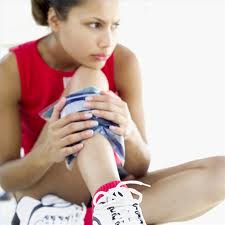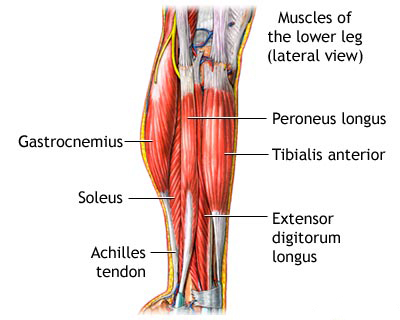Shin Pain
Shin pain is a common complaint especially among athletes. Shin pain can generally occur in one or more of three structures:
- tibia or fibula bone – stress fractures
- tenoperiosteum (connective tissue insertion of muscles into the bone) – tenoperiostitis
- muscle – compartment syndrome and calf muscle strains
Sport & Spinal Physiotherapy has helped many clients from Gungahlin and the wider Canberra community with all types of shin pain syndromes.
Shin splints is a general medical term denoting medial tibial stress syndrome, a slow healing and painful condition in the shins, usually caused by exercise such as running, jumping, swimming, dancing or other sports. Ten to fifteen percent of running injuries are shin splints.
The most common sources of shin splints are tenoperiostitis, compartment syndrome and tibial stress fractures. The onset of shin splints is most common after exercise, caused by high impact training, excessive training, poor technique or poor foot biomechanics such as flat feet or excessive foot pronation. Shin splints are also a common problem in military recruits during training. Some studies have suggested that shin splints are more common in women, but this may be caused by decreased physical fitness and smaller muscle size. Standing for long periods of time and wearing high-heeled shoes may also induce shin splints.
Tenoperiostitis is an inflammatory condition that occurs at the insertion of muscle through connective tissue into the bone. In the case of the shin it most commonly occurs at the medial (inside) border of the tibia at the site of muscle attachment. The pain typically decreases with warming up however can reoccur later after exercise especially being sore the following morning. Poor foot biomechanics with excessive pronation and flat feet are predisposing factors.

Compartment Syndrome is the compression of nerves, blood vessels, and muscle inside a closed space surrounded by an inelastic fascia (connective tissue) within the lower leg. This can lead to tissue death from lack of oxygenation from the blood vessels being compressed by the raised pressure within the compartment. Symptoms include pain and swelling with a tight, bursting feeling in the lower leg. The pain is worsened with exercise and relieved with rest. In some cases if nerve tissue becomes compressed, muscle weakness or sensory symptoms such as pins & needles and/or numbness may occur.
Tibial Stress Fractures can develop from unusual or repeated stress resulting in microtrauma to the shin bone that eventually fractures. Tibial stress fractures are a common sports injury and in most cases is associated with high impact training activities such as running and jumping. Usually a training error or inappropriate footwear is involved. Pain worsening as exercise progresses is the main symptom.
Calf Muscle Strain occurs when the calf muscle is pulled apart from the achilles tendon. Severe pain is felt by the victim and is often but not always accompanied by a “pop.” This injury usually happens during acceleration or changes in direction. The torn calf muscle may spasm, and contract forcefully. Bruises can show up in the leg, foot and ankle due to pooling of blood from internal bleeding. It may take some time for the bruises to occur, from hours to days depending upon where the tear occurred. The circumference of the leg will most certainly increase. This injury may take several months to heal. It is important to see one of our physios to fully rehabilitate the injury or otherwise another tear may occur down the track.
How can Sport & Spinal Physiotherapy help your shin injury?
In most cases, physiotherapy alone offers an effective solution for shin pain, however podiatry may help by correcting lower limb alignment with custom moulded orthotics. During your first visit, our physios will examine your shin area to determine what structures have been damaged. Establishing the correct diagnosis early is imperative as several injuries mimic symptoms yet have different treatment protocols. We use our unique ‘phase based rehab system’ to ensure all aspects of a full and lasting recovery are delivered. We will tailor a treatment plan to suit your needs, with you involved in the decision making. Early treatment will be focused on reducing pain and swelling and regaining muscle flexibility around the lower leg. Our physios will also use hands on therapy techniques to improve joint mobility and muscle flexibility. We will nearly always at each session provide home exercises of stretches and strength work so that you keep improving between sessions. The physiotherapist will then prescribe an exercise program to improve the strength and coordination of your lower leg, which are important for preventing re-injury. Massage, hydrotherapy, dry needling and our gym may also be used for best outcome. Towards the end of your program you will be given strategies to keep the pain away. The sooner we begin your shin rehabilitation, the faster your recovery and back to the things you love doing.
Why choose us for your shin pain?
- We listen, we care and we get results
- We fix the cause of your knee injury and not just the symptoms
- We have physiotherapy and podiatry for even the most complex shin injuries
- Our podiatrists can prescribe custom moulded orthotics to help your shin pain
- We can provide a running assessment if your shin pain is related to running
- We have therapists who have special training in shin injuries having completed further studies
- We have extensive experience in dealing with shin injuries
- We can refer you for further investigations such as x-ray or MRI if required
- Our therapists are passionate about sport and engage in an active lifestlye
- We understand the demands and technique involved in all sport types
- Our therapists have been recognised for their expertise having been national sporting team consultants
- Our physios and podiatrists can recommend the ideal footwear to suit your foot type
- We have advanced gym equipment to improve your lower leg strength and coordination
- Our massage therapists can sort out any tight shin muscles
- We can provide dry needling for pain management and accelerated healing
- We can supply practitioner only natural anti-inflammatory supplements to help healing
- Many of our physios work with local, state, national and international teams and athletes
- We give you cross training activities so you can maintain your fitness whilst injured
- We provide you with the tools to look after your health long after you leave our care
- We provide you with a guided return to sport with any technique modifications or training restrictions
- We can recommend referral to a medical specialist if need be to see if your shin injury requires surgery
